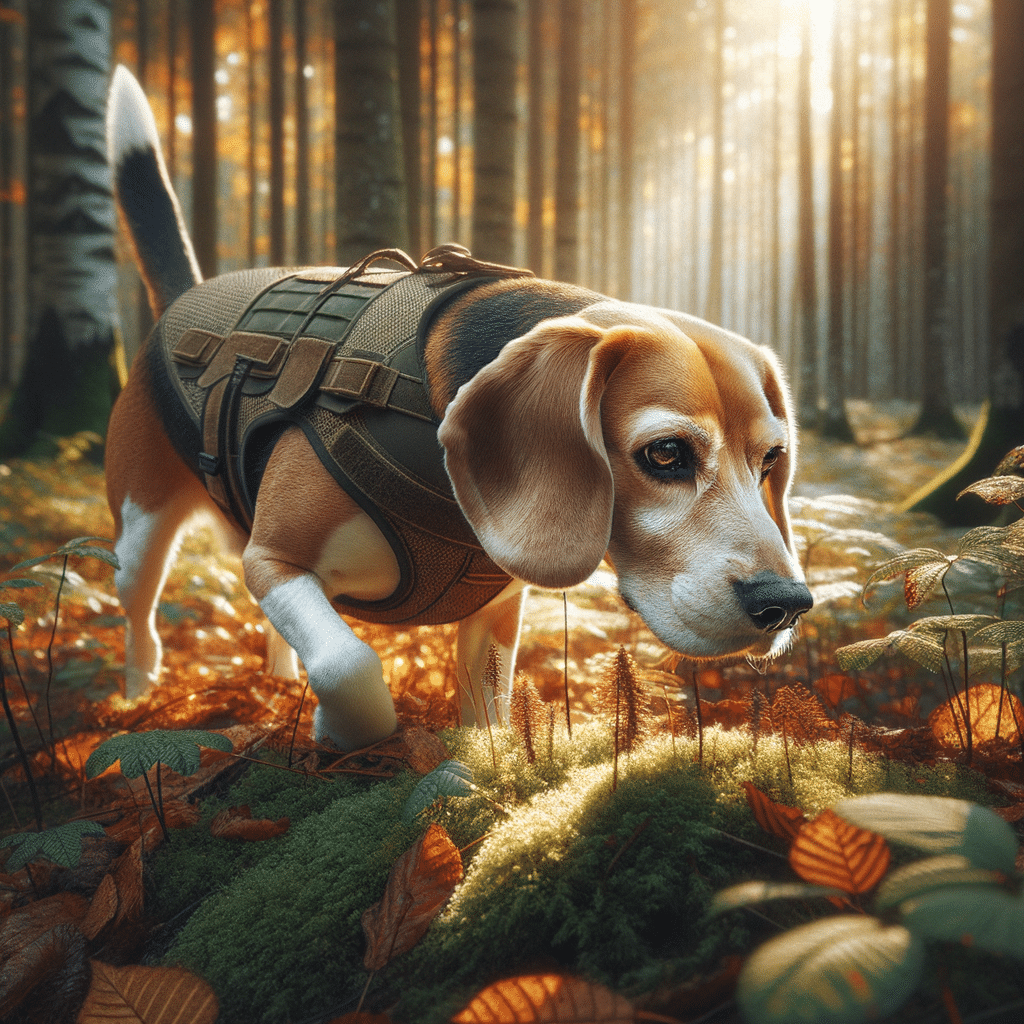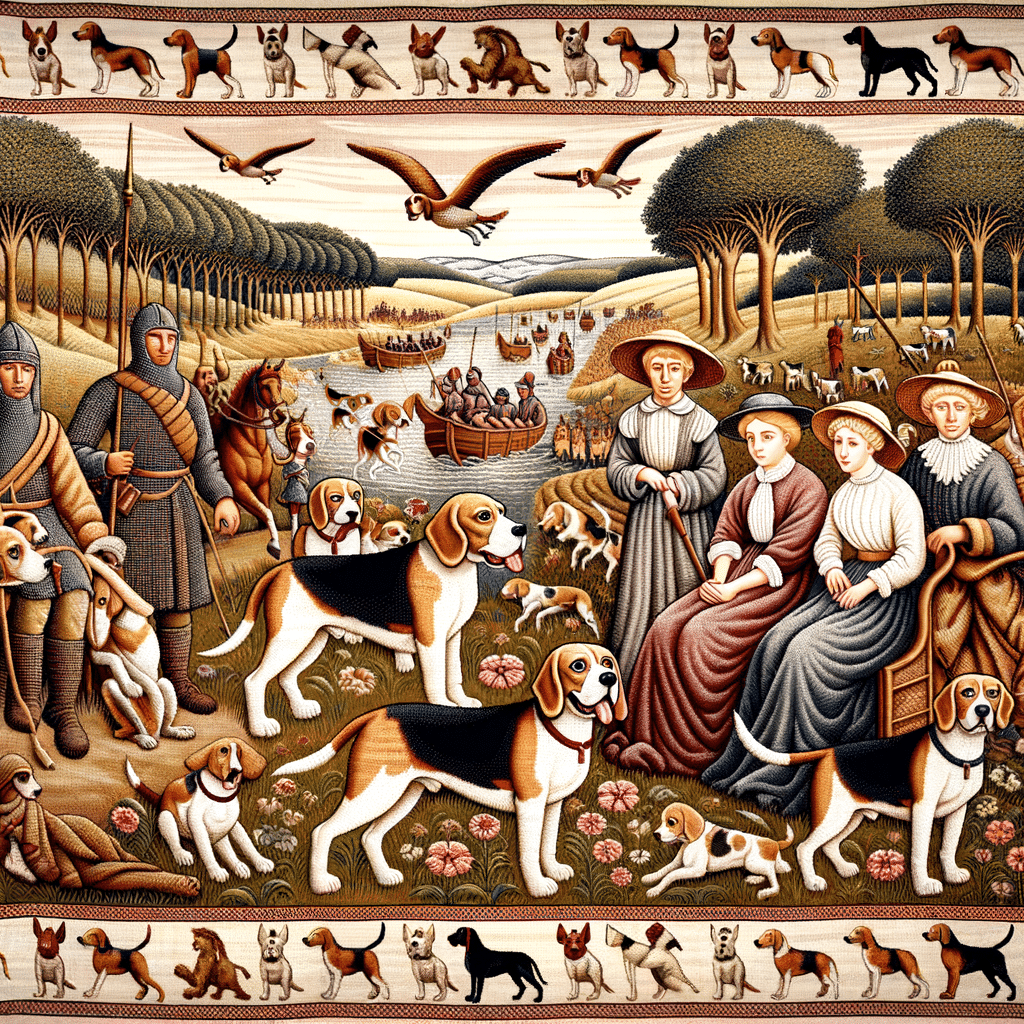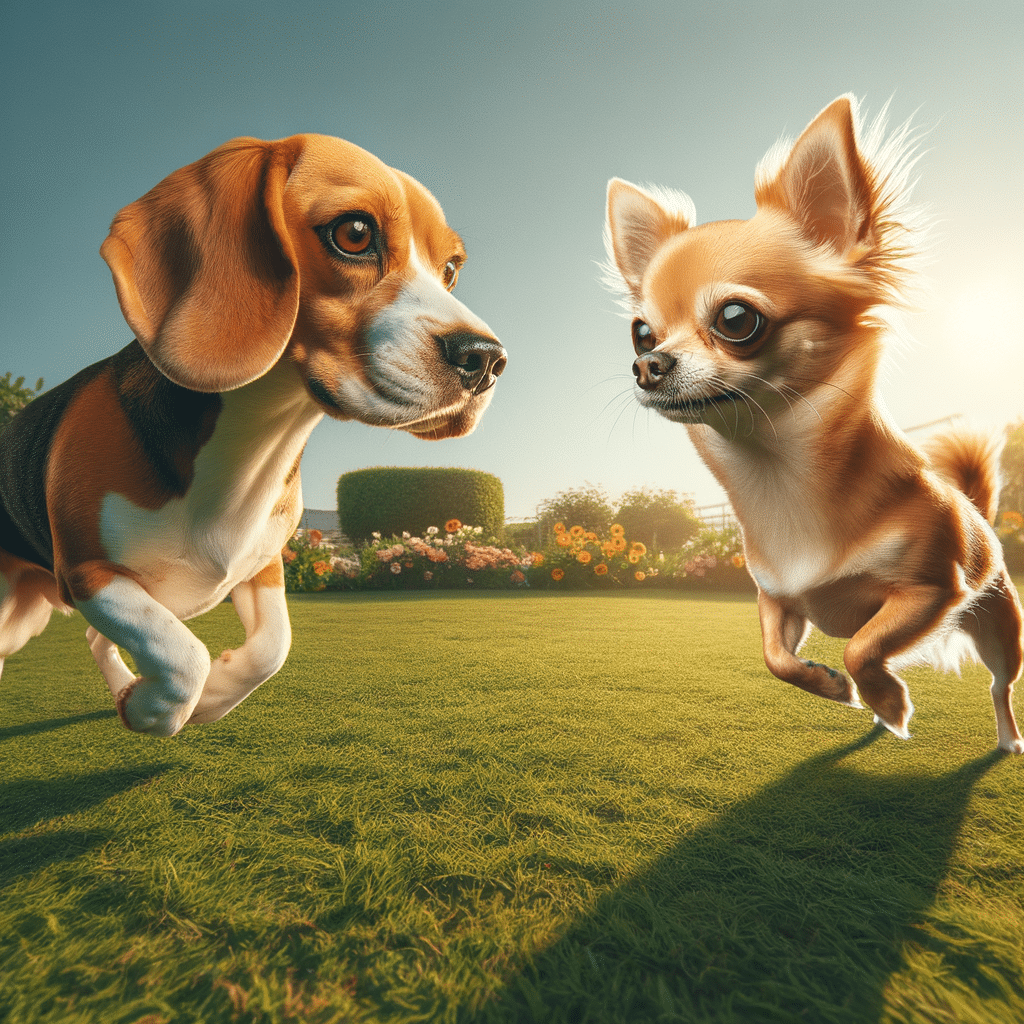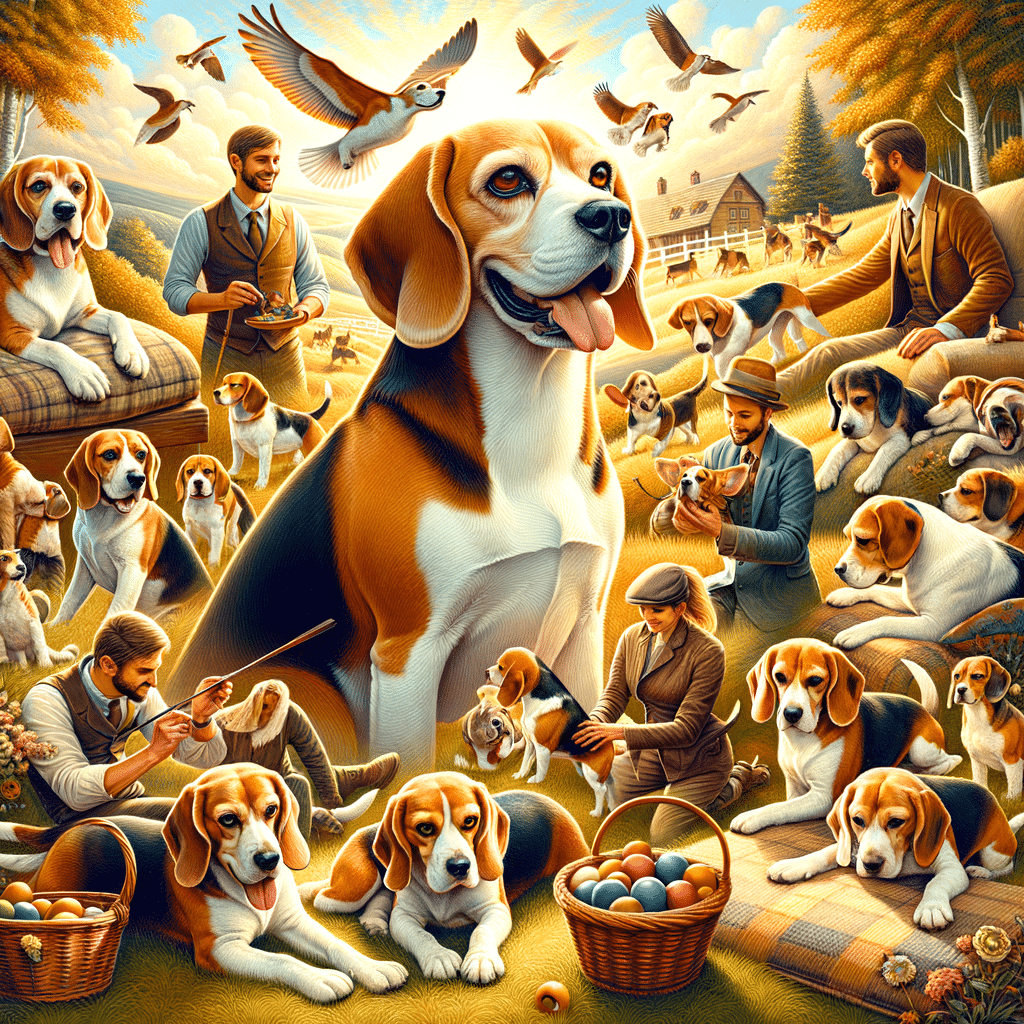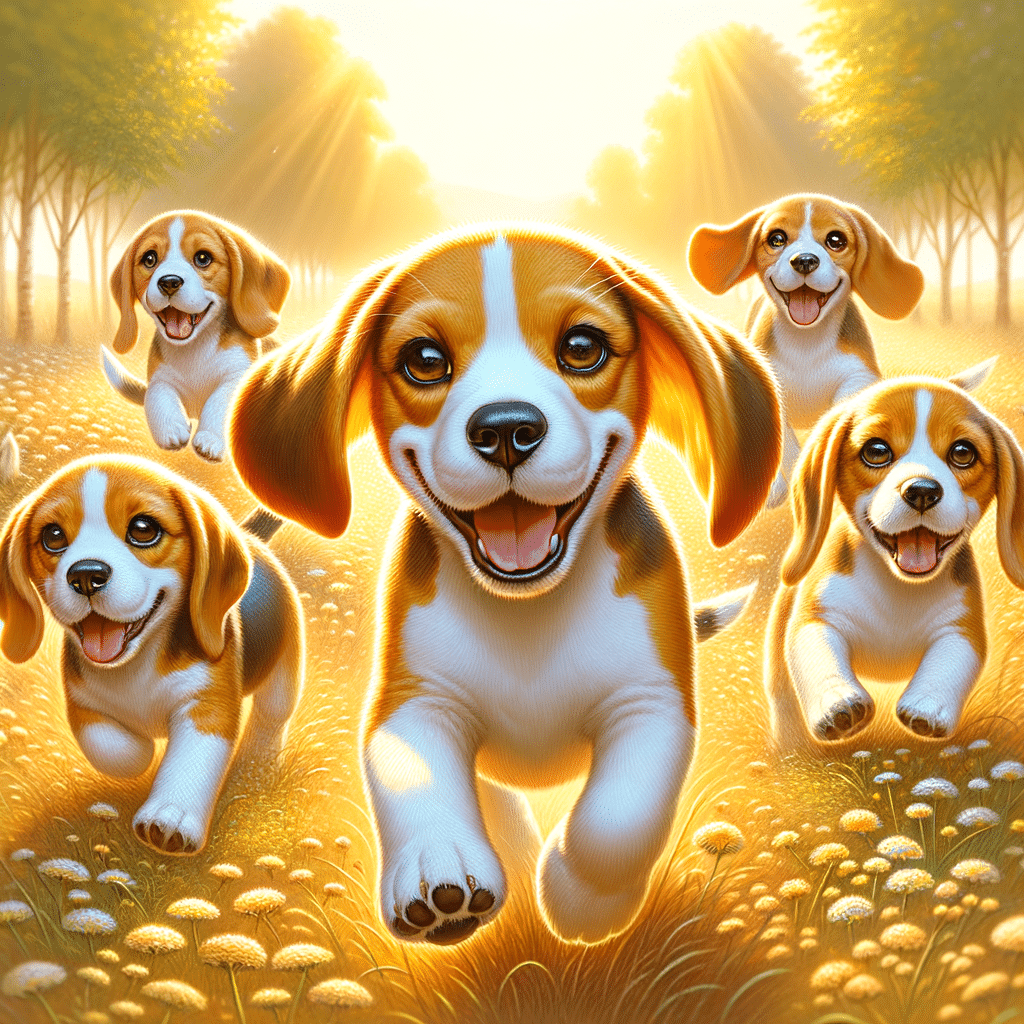Beagles are a small to medium-sized breed known for their incredible sense of smell and tracking ability. Originating in England, these hounds have historically been used for hunting due to their keen scent-tracking ability.
In This Article
Despite their hunting background, beagles have become one of the most popular family pets thanks to their size, temper3ament, and minimal care requirements. Once you learn the beagle basics, you’ll see that they’re easy to care for, and their friendly personality and adorable appearance make them an endearing part of your family.
With their compact stature, beagles come in two sizes. Each size is based on height at the withers, either under 13 inches or between 13 to 15 inches. The breed is recognized for its distinct tricolor coat, sturdy build, broad head with large, expressive eyes, and long, hound-like ears that can sweep the ground as they follow a trail.
The typical beagle personality is cheerful and outgoing, making it an excellent addition to active households. Potential beagle owners should know about the breed’s vocalization habits, as beagles can be loud. Beagles also need regular exercise to manage common behavioral issues like digging and wandering.
Highlights
- Beagles are celebrated for their sharp sense of smell and are historically known as hunting dogs.
- They exhibit a friendly and sociable temperament, making them great companions.
- Proper care and regular exercise are crucial to maintaining a beagle’s health and behavior.
Breed Origins and History
The beagle is a breed with deep historical roots. It is most commonly associated with hunting and is widely recognized by reputable canine organizations. This section explores the development of the breed and its historical functions.
Breed Development
Beagles trace their history to ancient times, originating from small hound breeds used for hunting in Greece. Over centuries, these hounds evolved in England, giving rise to the modern beagle. In 1885, the American Kennel Club (AKC) officially recognized the beagle, cementing its status as a distinct breed. The National Beagle Club was formed in the United States in 1888, further standardizing the breed.
Key Development Points:
- Origin: Ancient hound breeds from Greece.
- Development: Bred in England for comparable size and hunting prowess.
- Standardization: Formation of the National Beagle Club, AKC recognition in 1885.
Historical Roles
Historically, beagles served primarily as hunters due to their keen sense of smell and stamina. They excelled in rabbit hunting, often used in packs to track and hunt small game. The breed’s size and temperament made it ideal for this role, allowing hunters to follow on foot. The beagle was a fixture in British hunting traditions, and hunters in the United States adopted similar practices.
- Primary role: Hunting, specializing in rabbit hunting.
- Hunting attributes: Strong sense of smell, stamina, suitable size for foot hunters.
- Traditions: Integral to British and American hunting practices.
The breed’s history as a hunter and recognition by organizations such as the National Beagle Club and the American Kennel Club highlights its consistent role within the hound breeds category.
Physical Characteristics
The beagle is a distinct breed with physical traits that make it easily recognizable. These characteristics are both charming and functional.
Appearance
The beagle has a hardy and sturdy build and a compact body frame. Long, floppy ears are one of their most discernible characteristics, adding to their expressive nature. They generally have a short but dense double coat that provides them with insulation and protection.
Size and Color
Beagles come in two primary sizes:
- Beagles standing under 13 inches at the shoulder.
- Beagles standing between 13 and 15 inches.
In terms of color, they often have a tri-color pattern combining black, brown, and white. However, beagles can come in other colors, such as lemon, red, and white. Their coats may show any true hound color, and their size should be in the healthy weight range of 18-30 pounds.
Beagle Temperament and Personality
Beagles are renowned for their loyal and friendly nature. They exhibit a happy-go-lucky and easygoing personality, making them a well-loved companion.
Behavioral Traits
Beagles are inherently curious and energetic, traits that stem from their hound heritage. These dogs have a sharp sense of smell and are often led by their noses, which can sometimes cause them to wander off if not adequately controlled. Beagles require lots of mental and physical stimulation.
- Intelligence: Beagles are intelligent, but their curiosity can sometimes make training a challenge.
- Vocalization: Known for their distinctive howl, they can be quite vocal when they want attention or are left alone.
Social Characteristics
Beagles are naturally friendly and usually get along well with other dogs and pets. They tend to be very social, thrive on interaction with their human families, and often love being the center of attention.
- Family-oriented: Beagles bond closely with their families and are particularly loyal.
- Children: Generally, beagles are good with children, displaying a gentle demeanor.
This breed prefers companionship and can show separation anxiety if isolated for too long.
Caring for Your Beagle
Caring for a beagle requires attentiveness to their health needs, consistent grooming, adequate exercise, and firm yet gentle training methods.
Health and Nutrition
Beagles can be prone to certain health conditions, including hip dysplasia, epilepsy, and luxating patella. Beagles can quickly become obese, so a well-balanced diet is essential to maintain health and manage weight. Regular check-ups with a veterinarian will help catch any issues early.
- Dietary needs: Choose a high-quality dog food that meets AAFCO standards.
- Obesity prevention: Measure meals and limit treats.
Grooming and Exercise
Regular grooming and exercise are necessary to keep beagles healthy. They have a short, dense coat that requires frequent brushing to remove loose hair. As active dogs, beagles have high exercise requirements to maintain weight and stave off boredom.
- Grooming: Brush at least once a week; bathe as needed.
- Exercise: Walks two times a day.
- Interactive play: Daily mental stimulation (e.g., scent games.
Training Essentials
Beagle training should focus on positive reinforcement, consistency, and patience. Crate and potty training are beneficial and should be started early. If things get difficult, consider asking a professional dog trainer for help.
- Positive reinforcement: Use treats and praises to encourage good behavior.
- Consistency: Regularly reinforce commands and expected behaviors.
- Crate training: Introduce the crate gradually, ensuring it is a positive experience.
- Potty training: Set a consistent schedule and take them outside frequently.
Beagle as a Family Member
Beagles are outstanding family pets known for their affection and loyalty.
Integrating into the Household
When a family brings a beagle into their home, the housebreaking process is an immediate priority. Reputable breeders often provide guidance on early training to ease this transition. To prevent the dog from feeling territorial, introduce the beagle to their new home in a calm and controlled manner. Set up a specific area for the beagle, equipped with a bed and toys, to create a comfortable environment. Maintain consistency with rules and routines to help the beagle understand and adapt to your lifestyle quickly.
Housebreaking tips:
- Establish a routine for feeding and going outside.
- Use positive reinforcement when the beagle follows house rules.
- Be patient and consistent.
Bonding and Play
Regular playtime will help you bond with your beagle. Beagles typically form strong relationships with family members and are known for choosing a particular person to bond with closely. Activities such as fetch or tug-of-war strengthen your connection with your pet while providing the necessary exercise that beagles crave.
Bonding activities include:
- Daily walks and runs.
- Interactive games that stimulate their mind.
- Quiet time together to build trust and affection.
These activities will help your beagle flourish and become a cherished and well-adjusted family pet.
Conclusion
Training beagles can present challenges, notably in maintaining their attention due to their strong sense of smell and instinct to follow scents. Effective communication, through consistent commands and positive reinforcement, is required to overcome these training obstacles.
While beagles are affectionate and friendly, they require owner commitment to training, exercise, and interaction. If you’re willing to invest time and effort, a beagle will be a delightful addition to your life.
Frequently Asked Questions
Beagle owners often have specific questions about training, behavior, and the breed’s suitability.
What are the best methods for training a beagle?
Training a beagle requires patience and consistency. Positive reinforcement techniques, such as treats and praise, are most effective. They are more likely to respond and learn if they associate the training with a positive experience.
What are the common traits of an adult beagle’s behavior?
An adult beagle is known for being curious, friendly, and affectionate. They possess a strong instinct to follow scents and may exhibit stubbornness, making consistent training from a young age essential.
How can I effectively teach my beagle to respond to the “come” command?
Start in a controlled environment without distractions to teach a beagle to come when called. Use a happy tone of voice and reward them with treats or affection for successful responses, gradually increasing distractions.
How can you prevent a beagle from barking excessively?
Preventing excessive barking begins with understanding the cause, such as boredom or alerting to stimuli. Provide adequate physical exercise and mental stimulation. Training them to respond to a quiet command can also reduce unwanted barking.
What techniques work well for teaching a beagle to track scents?
Teaching a beagle to track scents plays to its natural abilities. Start with simple games of hide-and-seek using strong-smelling treats or toys. As they improve, create more complex scent trails for them to follow.
How suitable are beagles for first-time dog owners?
Due to their size, temperament, and social nature, beagles are suitable for first-time dog owners. However, potential owners should be prepared for their need for exercise, mental stimulation, and patience with training.
